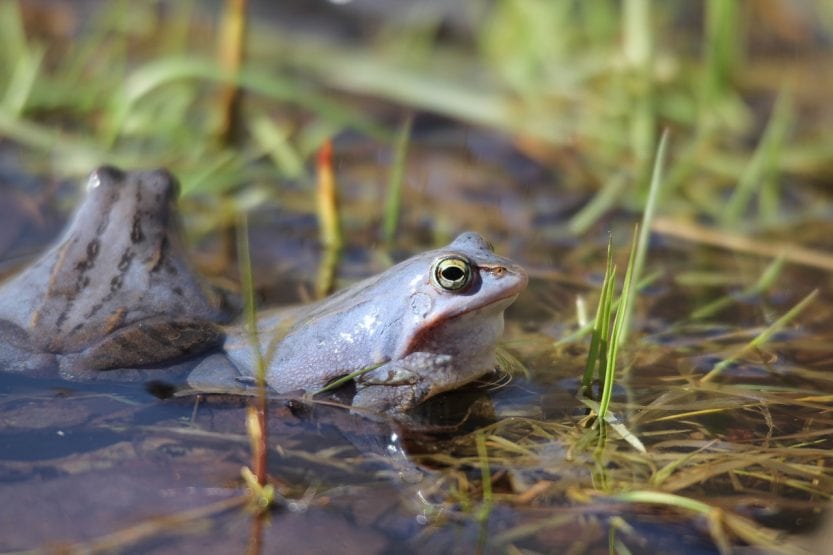Some amazing things that are blue naturally and one of them is the moor frog! No, the amphibian does not look blue always. Only male moor frogs turn into an incredible blue during the mating season.
The scientific name of this species of fascinating frog is “Rana arvalis” which when translated means “frog of the field”. That gives a fair idea about their favorite habitat. Moor frogs have another name. They are also called “Altai brown frog”. The name is related to the Altai or Altay Mountains in Central and East Asia, where a considerable population of the frog species is found. Moor frogs are considered to be among the most plentiful amphibians that live in marshes and ponds of Central and Eastern Europe, West Siberia, parts of Asia.
These frogs thrive in open habitats like damp meadows, wet hearth, marsh forests, peat bogs where the groundwater level is high. They can live as long as 11 years in their wild natural habitat.
Scientists say 178 frog species around the world undergo color change during the mating season. Male frogs flaunting vibrant greens, reds, and yellows are most common. Although it may last for a few hours, days, or stretch for a week, it’s a spectacle to witness. That makes male moor frogs one of the most interesting living things that are blue naturally during their breeding season.
Why do male moor frogs change color?
To understand why some moor frogs look blue during a certain time of the year one has to understand certain things. The strange color change in male moor frogs happens during the breeding season. The reason behind the noticeable blue coloration is to attract females. Certain animal species are considered explosive breeders and moor frogs fall under this category. The spawning season is brief, the competition fierce, and the blue coloration is an adaptation to attract females. The blue coloration helps frogs of other species to recognize male moor frogs and also prevents inter-species reproduction. In the crowd of hundreds, it saves the female time to spot a male frog quickly and easily.
It is a spectacular show during the breeding season when you can see hundreds of things that are blue near the habitat of moor frogs. In different parts of the world, visitors flock to nature parks to watch this stunning occurrence. Another surprising feature is, the frogs are active and blue only when the sun shines. The blue coloration and change of appearance is short-lived and lasts only for a few days. Once the courtship activity is over in March and April, the impressive look of the male frogs fades away.
How does a moor frog look?

Moor frogs fall under the category of “real frog”. A usual moor frog is usually 5-6centimetres in length with a slim body. From the top, the body of a male as well as a female moor frog appears in shades of brown like common frogs.
However, they are also found in shades of reddish-brown, pale olive, shades of yellow, and gray.
There are noticeable dark spots on the dorsal side. Most of them have a visible longitudinal line running through the middle of their body which appears quite bright. The ventral side of the body is light yellowish and missing any speckles. These frogs have a forked tongue, large eyes, and horizontal pupils. Their hind legs are short and the feet partly webbed.
Looking at a male frog’s ear or the tympanum one can distinguish between the genders. If the ear located behind the eye is bigger compared to the eye of the frog, it’s a male. There are other ways of distinguishing males from females. Nuptial pads or the thumb pads present in males distinguish them from the other sex. Males also typically have a paired guttural or vocal sac. The main purpose of this is to amplify the mating call or for better mating advertisement. This is probably the only visible external thing that can help in determining the sex of most frogs.
With a short and pointy mouth, and a slim body, a male moor frog in usual times does not look even close to things that are blue. The males only change their color during the spawning season to impress the female. This unique exhibition of color during the courtship activity is a natural wonder. This species of semi-aquatic frog is evenly adapted to living in the water and on land.
Diet
Moor frogs are mostly carnivorous. They thrive on algae, small insects like the diving or aquatic beetles, and the slug. These frogs do not feed during the mating season. The newly metamorphosed froglets that have turned from a tadpole to a frog scavenge on micro-arthropods and hexapods like collembolan. No, the frogs don’t eat things that are blue in any way to get their significant blue color!
Mating rituals of moor frogs
The ideal mating season of moor frogs is from March to April depending on the weather condition of the region where they live.
The mating call of moor frogs can be heard from far away. The male frogs make a loud gurgling sound that matches the noise of air coming out of an empty bottle with a narrow mouth that’s placed underwater.
In the bog or marsh where the water is shallow, a number of males congregate and start a loud frog chorus. The concert continues day and night for several days and the pitch increases when the sun shines. A female moor frog usually lays 500 to 3,000 eggs in warm and shallow waters during a particular season. The eggs look like eggs of any other frog and are laid on the leaves and shoots of plants in the marshy lands. Moor frogs can live up to ten years in their natural habitat and attain sexual maturity in two to three years.
The larvae start hatching in 6 to 16 weeks depending on factors like the weather and the nutrition available. Metamorphosis happens in June or July and the baby frogs are ready to move on land after that. Moor frogs do not travel far from their homes. The adult frogs remain 1000 meters within their spawning grounds.
The spawning grounds of moor frogs are usually in wetlands with high groundwater levels. These frogs like to reproduce in areas that are poor in nutrients, less acidic, rich in aquatic plants, and free from fish. That makes ponds, ditches, small lakes, shallow tidal areas perfect locations for spawning. These frogs prefer to hibernate on the surface of the water rather than at the bottom of marshes or ponds.
Metamorphosis

Moor frogs are semi-aquatic amphibians like newts and salamanders and the eggs hatch with adaptations to breathe in water. They go through a natural process of change and the adults grow the capability of breathing in air.
The metamorphosis of eggs to tadpoles and adult frogs usually happen during the time between June and October. The hatched larvae measure around 45 mm. They appear like tiny, dark, metallic dots. They only start eating algae and tiny invertebrates once they turn into tadpoles.
Defense
Moor frogs do not have any striking physical appendages that they can use to fight their enemies so what do they do when they sense danger? The frogs simply move away from danger or a predator by leaping away from it and hiding in the dense grass or the sludgy soil. Animals like the beaver are a natural enemy of an adult moor frog. Insects like dragonflies and hawkers may prey on the tadpoles.
Hibernation
Since they are “true frogs”, moor frogs hibernate during the winter months. The time of the year depends on the region where they live. In the warmer areas the winter-sleep may begin in November and continue till February, whereas in colder climates, it may last from September and continue till June. After winter is gone, the adults turn to reproduction in low lying wet areas. That includes ponds, marshes of European countries like Romania, Sweden, Denmark, Russia, Norway, Italy, Moldova, Latvia, Germany, the Netherlands, France, Ukraine. Also parts of China and Mongolia in Asia.
Adaptability

The type of land and environment where the moor frog can live are varied. That helps this frog species to survive urbanization and loss of natural habitat. This species of frog can live in the Tundra, steppe forests, glades, swamps, gardens, meadows, and even in the semi-desert regions and even some urban areas.
Threats to moor frog population
Although moor frogs can survive in a varied range of surroundings, pollution, extensive land being turned into pastures, urbanization, droughts, and destruction of their habitats, may pose problems. The moor frog population is considered stable and not declining. This species is not included in the endangered or threatened list and their survival is not of great concern. The number of moor frogs is widespread in different regions, thanks to their ability to cope with their surroundings without much trouble. Among the list of living things that are blue in nature, moor frogs will continue to amaze people for years to come.




